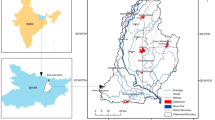Abstract
Morphometric parameters derived from three different sources viz., Survey of India topographic map (1:50,000), SRTM (Shuttle Radar Topographic Mission 90 m) and DEM derived from ASTER (Advanced Spaceborne Thermal Emission and Reflection Radiometer — 30 m) are evaluated to examine any difference within the results for the proper planning and management of the watersheds. Extracting drainage network from DEMs is mainly based on the flow of water from higher to lower elevation and steepest descent in a pixel. Common morphometric parameters are considered for analysis. The results show that the morphometric parameters derived from the SRTM and ASTER data provide good and satisfying results. The results will be more efficient when the DEM cell size is smaller or the resolution of the image is higher.
Similar content being viewed by others
References
Band LE (1986) Topographic partition of watersheds with digital elevation models. Water Resour Res 22: 15–24
Biswas S, Sudhakar S, Desai VR (1999) Prioritisation of subwatersheds based on morphometric analysis of drainage basin: aremote sensing and GIS Approach. J Indian Soc Remote Sens 27: 155–166
Fairfiled J and Leymarie P (1991) Drainage network from grid digital elevation models. Water Resour Res 30(6): 1681–1692
Gottschalk LC (1964) Reservoir sedimentation. In: V.T. Chow (ed), Handbook of Applied Hydrology. McGraw Hill Book Company, New York, Section 7-1
Gurnell AM and Montgomery AR (1999) Hydrological applications of GIS. Wiley, Chichester, pp 176
Hadley RF and Schumm SA (1961) Sediment sources and drainage basin characteristics in upper Cheyenne River Basin. U.S. Geological Survey Water-Supply Paper 1531-B, 198 pp
Horton RE (1945) Erosional development of streams and their drainage basins. Hydrophysical approach to quantitative morphology. Geol Soc Am Bull 56(3):275–370
Krishnamurthy J, Srinivas G, Jayaram V and Chandrasekhar MG (1996) Influence of rock types and structures in the development of drainage networks in typical hardrock terrain. ITC Journal 3–4:252–259
Kumar R, Kumar S, Lohani AK, Nema RK and Singh RD (2000) Evaluation of geomorphological characteristics of a catchment using GIS. GIS India 9(3):13–17
Langbein WB (1947) Topographic characteristics of drainage basins. U.S. Geol. Surv. Water-Supply Paper 986(C): 157–159
Macka Z (2001) Determination of texture of topography from large scale contour maps. Geografski Vestnik 73(2):53–62
Maidment DR (2002) ArcHydro GIS for water resources. ESRI Press, California
Mark DM (1983) Relation between field-surveyed channel network and map-based geomorphometric measures, Inez Kentucky. Am Assoc Geographers 73(3): 358–372
Mesa LM (2009) Morphometric analysis of a subtropical Andean basin (Tucuman, Argentina). Environ Geol (2006) 50: 1235–1242
Miller VC (1953) A quantitative geomorphic study of drainage basin characteristics in the Clinch Mountain area, Virginia and Teimessee, Proi NR 389-402, Tech. Rep 3, Columbia University
Morris DG and Heerdegen RG (1988) Automatically derived catchment boundaries and channel networks and their hydrological applications. Geomorphology 1:131–141
Nag SK (1998) Morphometric analysis using remote sensing techniques in the Chaka sub basin, Purulia district, West Bengal. J Indian Soc Remote Sens 26(1&2): 69–76
Ozdemir H and Bird D (2009) Evaluation of morphometric parameters of drainage networks derived from topographic maps and DEM in point of floods. Environ Geol 56:1405–1415
Patton PC (1988) Drainage basin morphometry and floods. In: Baker V.R., Kochel, R.C., Patton, P.C. (eds) Flood geomorphology. Wiley, USA, pp 51–65
Reddy GPO, Maji AK and Gajbhiye KS (2004) Drainage morphometry and its influence on landform characteristics in basaltic terrain, central India-a remote sensing and GIS approach. Int J Appl Observ Geoinf., 6:1–16
Ritter DF, Kochel RC and Miller JR (1995) In process geomorphology. William C. Brown, Dubuque
Saran S, Sterk G, Peters P and Dadhwal VK (2010) Evaluation of digital elevation model for delineation of hydrological response units in a Himalayan Watershed. Geocarto Int 25: 105–122
Schumm SA (1956) Evolution of drainage systems and slopes in badlands at Perth Amboy, New Jersey. Geol Soc Am Bull 67:597–646
Singh S and Singh MC (1997). Morphometric Analysis of Kanhar River Basin. National Geographical J India 43(1): 31–43
Smith KG (1950) Standards for grading texture of erosional topography. Am J Sci 248:655–668
Sreedevi PD, Subrahmanyam K and Ahmed S (2004) The significance of morphometric analysis for obtaining groundwater potential zones in a structurally controlled terrain. Envi Geol 47:412–420
Strahler AN (1957) Quantitative analysis of watershed geomorphology. Trans Am Geophys Union 38:913–920
Strahler AN (1964) Quantitative geomorphology of drainage basin and channel networks. In: Chow VT (ed) Handbook of Applied Hydrology. McGraw Hill Book Co., New York, pp. 4–76
Tarboton DG, Bras RL and Rodriguez-Iturbe I (1991) On the extraction of channel networks from digital elevation data. TT Hydrol Process 5:81–100
Verstappen H Th (1983) Applied geomorphology. ITC, Enschede
Vittala SS, Govindaonah S and Home Gowda H (2004) Morphoinetrlc analysis of sub-watersheds in the Pawagada area of Tumkur district South India using remote sensing and GIS techniques. J Indian Soc Remote Sens 32: 351–362
Vittala SS, Govindaiah S and Honne Gowda H (2006) Digital Elevation Model (DEM) for identification of groundwater prospective zones. J Indian Soc Remote Sens 34: 305–310
Author information
Authors and Affiliations
Corresponding author
About this article
Cite this article
Ahmed, S.A., Chandrashekarappa, K.N., Raj, S.K. et al. Evaluation of morphometric parameters derived from ASTER and SRTM DEM — A study on Bandihole sub-watershed basin in Karnataka. J Indian Soc Remote Sens 38, 227–238 (2010). https://doi.org/10.1007/s12524-010-0029-3
Received:
Accepted:
Published:
Issue Date:
DOI: https://doi.org/10.1007/s12524-010-0029-3




